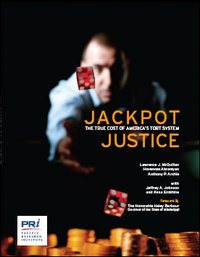 Source of report cover image: http://www.pacificresearch.org/pub/sab/entrep/2007/Jackpot_Justice/index.html
Source of report cover image: http://www.pacificresearch.org/pub/sab/entrep/2007/Jackpot_Justice/index.html
(p. A18) How does the legal system extract such an astounding amount from our economy? We applied the rent-seeking theory of transfers from economic science to pick up where past studies — including the highly regarded Tillinghast-Towers Perrin study — leave off. We began by examining the static costs of litigation — including annual damage awards, plaintiff attorneys’ fees, defense costs, administrative costs and deadweight costs from torts such as product liability cases, medical malpractice litigation and class action lawsuits. The annual static costs, $328 billion per year, are well in excess of previous Tillinghast estimates.
But $328 billion is only the beginning. After all, litigation doesn’t just transfer wealth, it also changes behavior, and often in economically unproductive ways. Any true estimate of the costs of America’s tort system must also include these dynamic costs of litigation — the impact on research and development spending, the costs of defensive medicine and the related rise in health-care spending and reduced access to health care, and the loss of output from deaths due to excess liability.
. . .
Based on data from previous studies, we determined that more than 77,000 people would have been alive today and contributing to the workforce, but are not because of a failure to enact comprehensive tort reforms in the states. The cost of foregone output from these lost workers is more than $7 billion each year.
What we’re left with, then, are annual dynamic costs of $537 billion resulting from our litigation system. Add that to the static costs of $328 billion and you arrive at the total of over $865 billion per year.
For the full commentary, see:
(Note: ellipsis added.)
McQuillan, Abryamyan, along with Anthony P. Archie, have co-authored a report entitled Jackpot Justice: The True Cost of America’s Tort System that elaborates on many of the issues sketched in the commentary excerpted above. You can download a free PDF copy at: http://www.pacificresearch.org/pub/sab/entrep/2007/Jackpot_Justice/Jackpot_Justice.pdf

My future occupation compels me to offer at least a partial defense of tort litigation. Perhaps the best cinematic illustration of a positive effect of tort litigation comes from Fight Club. While sitting on a plane, Edward Norton explains to a fellow passenger how a car company decides if they are going to issue a recall. The gist of the conversation is if the cost of recall is less than no recall, the car company will issue a recall. If the projected cost of a recall is greater than just letting the defective product remain on the market (cost of recall > cost of no recall), the defective car remains on the market. This is perfectly consistent with the presumed rational behavior of actors in the market. While reputation, bad Consumer Reports ratings, etc. are part of the costs of not issuing a recall, the 800 lb gorilla is tort litigation. By legislatively lowering the costs of tort litigation (by limiting the circumstances that a lawsuit is available, capping damages, doing away with punitives, etc) a marketplace filled with rational actors would be apt to issue fewer recalls, presumably resulting in more random car fires, mechanical failures, etc.
While the media hypes medical malpractice litigation, cases where the liability is disputed are loser cases. However, when doctors cut off the wrong leg or do a surgery on patient X that was supposed to be for patient Y, it doesn’t offend me when they get whacked with a million dollar lawsuit. I’m not advocating for lawsuits every time a procedure isn’t successful, just saying there are circumstances where a costly lawsuit does not offend my conscience.
As my first sentence stated, this is only a partial defense of tort litigation. I reckon there are hundreds of lawsuits filed annually that would shame me as an attorney (suit pants in NJ, hot coffee at McDonalds, etc). I caution against depriving deserving victims of adequate recourse to stop the relatively few, though highly visible, crooks.
Also, as Dr. Dach indicates in his comment, lawsuits can be used as a free market indicator of the safety of pharmaceuticals. Litigation isn’t evil per se!